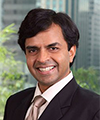In-House Trading System : Relevance and Challenges
|
Speaker (s):

Manoj Thulasidas
Founder, CEO at Analytics SME
|
|
Date:
Time:
Venue:
|
|
September 7, 2016, Wednesday
2:00pm - 3:00pm
Meeting Room 4.4, Level 4
School of Information Systems
Singapore Management University
80 Stamford Road
Singapore 178902
We look forward to seeing you at this research seminar.

|
|
About the Talk
All banks use trading systems to track and risk-manage their trading books. Although vended trading platforms such as Murex do an excellent job in most aspects of trading, they are not nimble enough in responding to changing market conditions. A well-designed in-house system can monetize the mathematical intelligence generated in the bank. However, it has to be carefully put together, taking into account the needs, work paradigms and perspectives of all the business units that deal interact with it. In this talk, we examine why an in-house trading platform is necessary to capture transient market opportunities, the challenges it poses both from the system and business perspectives.
About the Speaker
Manoj Thulasidas was born in the picturesque hill resort of Munnar in south India in 1965. He received his undergraduate degree from the Indian Institute of Technology, Madras in 1987. A physics aficionado, he then joined the Physics Department of Syracuse University as a graduate student. He studied fundamental particles and interactions at the CLEO collaboration at Cornell University during 1990-’92. After receiving his Ph.D in 1993, the author moved to Marseilles, France and continued his research with the ALEPH collaboration at CERN, Geneva. During his 10-year career as a research scientist in the field of high energy physics, he co-authored over 190 publications.
Always inquisitive about the interplay between mind and matter, perception and philosophy and their implications in physics, the author joined the Kent Ridge Digital Labs (KRDL, later to be renamed I2R) in Singapore in 1998 to explore various human body-based measurements and systems. His work at this institute resulted in four invention disclosures, two of which have been filed for patent, and numerous academic papers. Later on, he was involved in the NeuroInformatics group, focusing on Brain Machine Interface and neural signal acquisition and processing, which gave him the perfect opportunity to further understand and appreciate the role of perception in physics. The outcome of the author’s professional research career and his philosophical bend of mind is his first book, The Unreal Universe.
In 2005, Manoj switched to quantitative finance, and joined OCBC, a regional bank in Singapore. He led the quantitative analyst team for quantitative pricing model validation and other mathematical tasks. This middle office job, involving risk management and curtailing ebullient traders, gave him a thorough overview of pricing models and, perhaps more importantly, a perfect understanding of the conflict-driven implementation of the risk appetite of the bank. Later on, he moved to Standard Chartered Bank, taking care of their in-house trading platform, which further enhanced his "big picture" outlook and inspired him to write Principles of Quantitative Development.